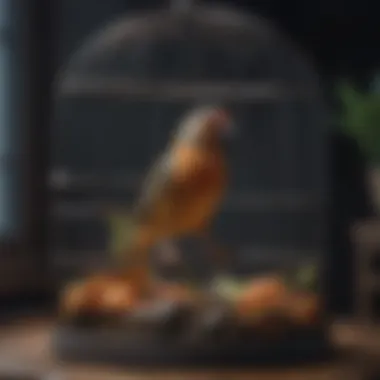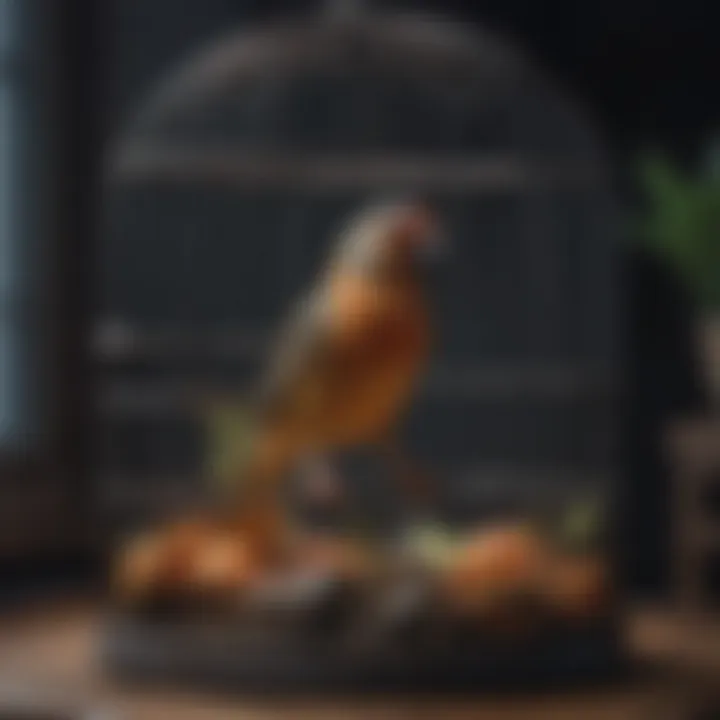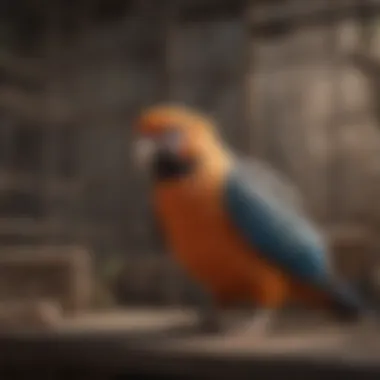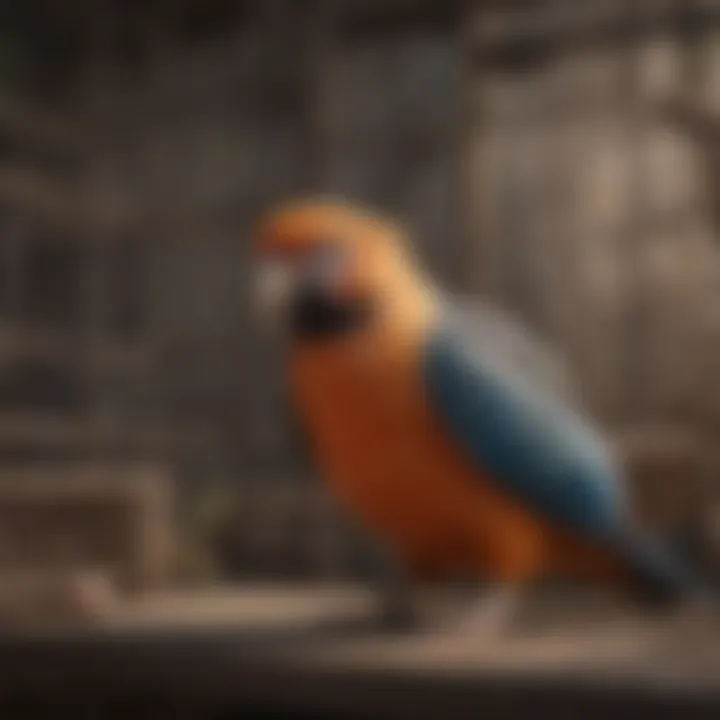Exploring Large Bird Cages for Avian Well-being


Intro
When you think of a home for your pet bird, the first image that probably pops into your mind is a cramped little cage hanging in the corner with a few perches and some food dishes. However, the reality is far from that outdated notion. In fact, more and more bird owners are beginning to recognize the immense value of providing a very large bird cage as a living space for their feathered friends. These expansive habitats can dramatically change a bird's quality of life, allowing for more movement, social interaction, and mental stimulation.
In this article, we’ll unpack the many benefits that come with very large bird cages, taking a closer look at their dimensions, materials, designs, and essential features tailored for various bird species. We’ll also dive into the positive psychological and physical developments that spacious habitats can foster in your avian companions. This is not just about aesthetics; it's about providing an environment where your pet can thrive, feel safe, and display its natural behaviors.
As we dig deeper, bird enthusiasts—whether you are new to birdkeeping or seasoned breeders—will find valuable insights. Sifting through best practices around cage care, behavioral needs, nutrition, wellness, and engagement activities can mean the difference between a stressed bird and a content one. Each element plays its part in ensuring your feathered friend lives a full and happy life. So, let’s spread our wings and dive into the first essential aspect of enhancing avian well-being through housing: Care Tips.
Understanding Very Large Bird Cages
Understanding the concept of very large bird cages is pivotal for anyone who brings avian companions into their lives. These spacious structures are not merely containers but rather vital habitats that can significantly enhance the quality of life for birds. As the saying goes, "a bird in the hand is worth two in the bush"; however, a bird in a cage that offers ample space is certainly worth more than just a cramped nook.
When we delve into this topic, several key elements emerge, both in terms of physical requirements and the emotional needs of birds.
Defining Very Large Bird Cages
Very large bird cages can be defined as spacious enclosures designed to accommodate a variety of avian species comfortably. Rather than offering the bare minimum for survival, these cages facilitate greater freedom and exploration.
Typically, a very large bird cage features additional height, width, and depth compared to standard cages, resembling a miniature avian habitat. This allows birds to spread their wings—literally! In general, a cage should be large enough to ensure that birds can fly short distances, stretch their wings fully, and engage in natural behaviors like climbing and perching.
The Importance of Space for Avian Species
The significance of space cannot be overstated. Just as people feel confined in small apartments, birds can experience stress and discomfort in overly cramped conditions. Birds are social creatures. Many species thrive on interaction, both with their kind and with their human owners.
A spacious environment fosters better mental health for birds. Here are some benefits associated with providing ample space:
- Enhanced Physical Health: Larger cages encourage movement which is crucial for muscle development and preventing obesity.
- Natural Behavior: Birds that have space to roam are more likely to exhibit natural behaviors—such as foraging, flying, and playing—which are essential for mental stimulation.
- Reduced Stress: Spacious settings can mitigate feelings of frustration and stress, especially in territorial species that may become agitated in tight quarters.
"The essence of a happy bird lies in the freedom to experience life in flight, even when confined by bars."
In summary, understanding the concept of very large bird cages encompasses recognizing how crucial space is to the well-being of birds. It not only enriches their lives physically but also plays a significant role in their psychological health, making it a fundamental consideration for bird owners and enthusiasts alike.
Choosing the Right Size
Choosing the right size for a bird cage is nothing short of essential when it comes to ensuring an environment that promotes the well-being of avian companions. An adequately sized cage creates not only a living space but also a habitat that allows birds to express their natural behaviors, engage in activities important for their health, and feel secure. In a world where space is sometimes at a premium, it can be tempting to opt for a smaller cage; however, this decision can adversely affect the overall quality of life for pet birds.
Getting the size right contributes significantly to the physical and psychological health of the bird. The larger the cage, the more freedom the bird has to fly, play, and interact. Additionally, larger cages are typically easier to furnish with engaging features like perches, swings, and toys. A properly sized cage becomes a playground rather than just a living area, which fosters an enriched, stimulating environment for our feathered friends.
Guide to Dimensions for Different Bird Types
Birds come in various shapes and sizes, and so do their cage requirements. The dimensions of a cage should cater to the specific needs of individual species. For instance, smaller birds like finches and canaries thrive in cages that offer horizontal space to flit from perch to perch, while larger species like macaws need cages that accommodate their wingspans and encourage vertical movement.
Here’s a quick rundown of recommended dimensions:
- Budgerigar: 18" x 18" base, height of at least 36"
- Cockatiel: 24" x 24" base, height of around 36" to 48"
- Amazon Parrot: Minimum 36" x 36", height of 60"
- Macaw: 48" x 36", height of at least 72"
These size recommendations are starting points to ensure a comfortable living environment that allows for movement and interaction.
Understanding Wing Span and Flight Patterns
Birds are brilliant at utilizing space through their wings. Their wing span and flight patterns are key indicators of how much space they truly need. Different birds also have unique flying habits; some may prefer short bursts of flight, while others might be gliders who enjoy swooping around the enclosure.
Knowing your bird’s natural flight habits helps in choosing a cage that feels less confined. A sparrow, for example, typically flits short distances, so a wider cage is beneficial. In contrast, a cockatoo may enjoy climbing up to high perches and then taking swooping flights. An understanding of these habits can help you select the cage that best mirrors their natural behaviors.
How Activity Level Affects Cage Size Requirements
Not all birds are created equal when it comes to energy levels. Some species are naturally hyperactive and require more room, while others may be more sedentary. For instance, conures are known for their boisterous and lively nature, and they tend to need larger cages compared to more laid-back species like doves. If a bird isn’t given ample space to explore and move, it may exhibit signs of stress or health issues linked to inactivity.
It's wise to assess the specific activity level of your chosen bird species early on; this can save a lot of heartache down the road. An energetic bird benefits from a spacious cage that allows for exploration, which can also encourage optimal physical health. Bird owners may want to consider grants of additional space depending on the individual quirks and tendencies of their avian companions.
Choosing the right cage size doesn’t just impact the physical habitat of your bird; it greatly influences their mood, behavior, and overall well-being.
In summary, a thoughtfully chosen cage size can improve a bird’s life significantly. Don’t just think of the cage as a box; instead envision it as a buzzing ecosystem for your feathered friend! With the proper dimensions, an understanding of their natural behaviors, and recognition of their activity levels, bird owners can create enriching, spacious environments that promote happiness and health for their pets.
Constructing Very Large Bird Cages
Building a spacious and secure environment for pet birds is not just about aesthetics; it’s a matter of their well-being and overall quality of life. The structure and design of very large bird cages significantly impact the physical and psychological health of these avian companions. A well-constructed cage offers safety, durability, and comfort, essential for fostering a happy habitat. Selecting the right materials and features is crucial, as they directly influence not only how birds interact with their space but also how they thrive within it.


Materials Used in Cage Construction
When it comes to the very large bird cages, the choice of materials plays a pivotal role. Ideally, the materials should be safe for birds, easy to clean, and capable of standing the test of time. Common materials include stainless steel, powder-coated metal, and high-quality wood.
Stainless steel, while often pricier, provides excellent durability and resistance to corrosion, making it easier to maintain. It also doesn’t retain harmful chemicals, unlike some lower-quality materials that can be toxic to birds. In contrast, wood can offer a more naturalistic appearance. However, care must be taken to select untreated and non-toxic types, as certain wood species are harmful to birds.
Key Takeaway:
Using high-quality, bird-safe materials will ensure that the bird’s environment remains both functional and healthy, reducing the risk of health issues and enhancing their everyday experience.
Design Features to Consider
The design of a bird cage should go beyond mere appearance. It has to integrate functionality, enabling birds to exhibit their natural behaviors while providing owners with practical usage.
Access Points and Doors
Access points and doors are essential in any cage design. They should facilitate easy cleaning and interaction between owner and bird. Having multiple access points allows for better accessibility and ease of use. A well-placed door can minimize stress for the bird during cage cleaning or other interactions.
Unique Features:
- Safety Locks: Secure locking mechanisms prevent escapes.
- Placement: Doors positioned at the top and sides make it easier to interact and access food bowls or toys.
The importance of having reliable access points cannot be overstated. It keeps the owner engaged while also providing the birds with a sense of security during handling.
Perches and Accessories
The type of perches and accessories plays into the overall habitat's functionality and comfort. Varied perch sizes and materials support foot health and promote exercise. Natural wood perches, for instance, allow birds to grip in ways that mimic branches in the wild.
Key Characteristics:
- Multi-Functional Perches: Incorporating swings or ladders into the design encourages active movement and can intrigue a bird's curiosity.
Having diverse perches not only aids in physical fitness but also contributes to an enrichening environment, allowing birds to engage mentally and physically with their surroundings.
Ground Space Utilization
Maximizing ground space is key in a very large bird cage. Birds need room to move around freely and make use of their environment.
Benefits:
- Activity Zones: Designating areas for feeding, playing, and resting allows birds to explore and interact at their own pace.
- Obstacle Courses: Utilizing various levels through platforms or ramps can enhance their exercise routines while mimicking their natural habitats.
Proper ground space utilization helps prevent boredom and discourages unhealthy sedentary behaviors. It enables birds to indulge in natural behaviors, ultimately leading to happier, healthier pets.
Remember, thoughtful construction and design will further enhance the birds' living arrangements, ensuring that they remain content and healthy in their space.
In summary, constructing very large bird cages involves a well-rounded approach to materials, design, and functionality, creating an environment where birds can thrive.
Psychological Benefits of Space
The psychological well-being of pet birds is often overlooked, but it's crucial to acknowledge how the size and structure of their cage play significant roles in their state of mind. Providing ample space fulfills not just the basic need for movement but also caters to their social behaviors, territorial instincts, and overall happiness. When birds feel secure and stimulated, they exhibit less stress and more natural behaviors, which fosters a healthier mind and body.
Social Interaction and Territoriality
Birds, particularly species that thrive in communal settings, crave interaction. Very large bird cages allow for multiple birds to coexist without the constant pressure of proximity. Think about it: imagine sharing a small room with friends—you can enjoy each other's company, but too close a space breeds conflicts. In a larger cage, birds can maintain their social interactions while carving out their own space, which is vital for their mental stability.
Moreover, some birds have strong territorial instincts. In a cramped environment, conflicts erupt as they compete for resources and personal space. A spacious cage minimizes these skirmishes, allowing birds to establish their territories comfortably. This supports a more peaceful atmosphere and reduces the chances of aggressive behaviors that can lead to stress or injury.
Reducing Stress through Environmental Enrichment
Stress in captive birds can manifest in various ways, such as feather plucking, excessive vocalization, or lethargy. One way to combat this is through environmental enrichment tailored to the bird's needs. With plenty of room in a large cage, owners can implement various activities and enhancements that keep birds mentally engaged and physically active.
Setting up a large cage with toys, climbing structures, and hiding spots creates an intriguing environment that encourages exploration. Birds are naturally curious creatures; when they have space to satisfy that curiosity, they are less likely to feel confined or bored.
Consider implementing a rotation system for toys and activities. Just like children, birds can lose interest in playthings after a while. By regularly introducing new elements, you keep them engaged and stimulate their minds, leading to healthier behavioral patterns.
"Keeping birds psychologically happy in a spacious environment cannot be underrated—it's as essential as providing food and water."
While the investment in a very large cage may seem daunting, the psychological benefits for the birds far outweigh the costs. A well-thought-out space enhances their overall well-being, bringing a mixture of joy and health to their lives. Maintaining that balance is key to ensuring that your feathered friends thrive, not just survive.


Physical Well-being and Cage Size
When it comes to keeping pet birds, the size of the cage is a major player in their overall physical well-being. Birds are not just beautiful creatures; they are intelligent beings that require ample space to thrive. A well-designed, spacious cage is not merely a luxury; it’s a necessity. The size of a bird's cage significantly impacts its health, behavior, and happiness. This section delves into why cage size matters, focusing on the specific elements that contribute to avian health, from obesity prevention to encouraging natural behaviors.
Preventing Obesity in Caged Birds
Obesity is a growing concern among caged birds, and one of the leading causes is inadequate space. Just like humans, birds need to move to burn calories. An undersized cage restricts their ability to exercise, leading to weight gain and health issues. Birds on the heavier side may face various challenges, including respiratory problems and joint pain that can significantly affect their quality of life.
To combat obesity, it’s important to consider the following factors:
- Cage Size: Larger cages allow for more movement, which decreases the likelihood of weight gain. A spacious cage encourages birds to fly, hop, and engage in behaviors that help maintain a healthy weight.
- Exercise Opportunities: Beyond just flying, cages should incorporate climbing opportunities such as ladders or branches. This diversifies the movement range and keeps birds active.
- Diet: While cage size affects physical activity, diet also plays a crucial role. Owners should provide a balanced diet with limits on high-calorie treats.
"The recommendation for cage size often aligns with the bird's wingspan, suggesting a cage that encompasses the ability to spread wings fully and move about freely."
Encouraging Natural Behavior and Movement
Birds are natural explorers; their instincts drive them to fly, climb, and forage. By ensuring that their cage is large enough, we facilitate behaviors that are essential for their emotional and physical health.
Here’s what to keep in mind for encouraging natural behaviors:
- Height and Width: A well-thought-out design includes more than just a larger footprint; vertical space is equally important. Birds need to utilize their wings to fly up and down within the cage rather than merely across.
- Environmental Complexity: Adding branches, ropes, and toys creates an enticing landscape that encourages exploration. Birds will naturally seek out these activities, leading to physical movement.
- Social Interaction: Birds are social creatures. If they live in groups, a larger cage allows them to interact without feeling cramped. This not only supports physical movement but also promotes a healthy social environment.
In sum, physical well-being in our feathered friends goes far beyond merely feeding them and ensuring their cleanliness. Owners should take the initiative to understand the importance of spacious habitats that allow their birds to express natural behaviors. Not doing so can lead to calamitous consequences that may shorten their delightful companions' lives.
Maintenance and Cleaning of Large Cages
Maintaining and cleaning large bird cages is crucial in promoting not only the health of the birds but also an overall satisfying environment for your feathered friends. When you own a bird, you adopt the responsibility of creating a clean, safe, and engaging space. Dirty cages can quickly lead to health issues, such as respiratory problems, infections, and parasitic infestations. Hence, regular maintenance and cleaning should be top priority for pet bird owners, aspiring bird parents, and bird breeders.
In addition to health considerations, a clean and well-maintained cage promotes positive behavior in birds, decreases stress, and encourages natural activities. When birds are provided with a fresh and stimulating environment, they are more likely to exhibit vibrant behaviors like singing, playing, and socializing.
Routine Cleaning Protocols
Establishing a routine cleaning protocol helps maintain consistency, ensuring that both the cage and its occupants thrive. Here’s how you might structure your routine:
- Daily Maintenance: Start with a visual inspection. Remove any uneaten food and droppings every day. Most birds are prone to spills, so be prepared to clean the bottom of the cage. A quick wipe of the perches, food dishes, and toys can prevent bacteria buildup.
- Weekly Deep Cleaning: Once a week, you should perform a deeper cleaning. This involves taking out all accessories, toys, and food dishes and washing them with a vinegar-water solution. Disinfect the cage itself with a pet-safe disinfectant. Remember to rinse thoroughly to avoid any harsh chemicals lingering.
- Monthly Inspection and Maintenance: At least once a month, inspect the cage for any wear and tear. Pay attention to the bars, any sharp edges, and the ground space. If you find any damage, repair or replace parts to maintain a safe environment for your birds.
"A clean cage creates a happy bird; it’s the simple things that make all the difference.”
Selecting Appropriate Cleaning Supplies
Choosing the right cleaning supplies is essential for both the safety of the birds and the effectiveness of cleaning. Here’s what you should consider when selecting cleaning supplies:
- Natural Cleaners: Look for natural cleaning alternatives like vinegar and baking soda. These options are non-toxic and effective against dirt and bacteria. Avoid using harsh chemicals and scented products, which can harm birds.
- Disinfectants: When using disinfectants, ensure that they are specifically labeled as bird-safe. Some commonly used disinfectants include unscented soap solutions and enzymatic cleaners that are safe for avian species.
- Tools: Soft cloths and brushes are vital for cleaning. Avoid anything rough that can scratch the cage or damage accessories. Consider having a separate set of cleaning tools just for the bird area to minimize contamination.
- Waste Management: Invest in a waste management system that’s easy to handle and dispose of droppings securely to prevent odor and promote hygiene.
By adopting a structured approach to maintenance and employing safe cleaning supplies, you ensure that your birds not only live in comfort but thrive in their environment. Keeping their space clean is as much about them as it is about you. This reciprocal relationship fosters a healthier, happier life for both the bird and its owner.
Enrichment Activities for Birds in Large Cages
Creating an engaging and stimulating environment is vital for birds housed in very large cages. Enrichment activities significantly contribute to their overall well-being, stimulating their minds while encouraging physical exertion. Birds, like most creatures of habit, thrive on diversity in their surroundings. A cage devoid of such features could easily lead to boredom or even anxiety. Hence, incorporating various enrichment activities becomes a fundamental aspect of bird care that every owner should prioritize.
Providing Toys and Varied Environments
One of the simplest yet most effective ways to enrich a bird's environment is through toys. Selecting toys that mimic natural behaviors can be incredibly beneficial. For instance, chewing toys made of non-toxic wood encourage natural gnawing, which helps maintain their beaks. Similarly, toys that swing, rattle, or can be manipulated allow birds to exercise their curiosity as well as their body.
When considering the types of toys to add, think about the size of your feathery companion. Small birds like finches or budgerigars often appreciate colorful, lightweight items, whereas larger species such as macaws or cockatoos might require sturdier, more robust playthings. It’s ideal to rotate toys periodically to ensure they don't grow stale. This constant change keeps your bird alert and engaged.
Additionally, environmental variation is key. Setting up different levels within the cage, placing items at various heights, or even adding branches for climbing not only adds visual interest but also encourages the exploration inherent in your bird's nature. Similar to how we enjoy a well-arranged living space, birds too respond positively to an enjoyable layout.
"A vibrant cage is not just a luxury; it’s a necessity for a happy bird."
Creating Spaces for Exploration and Play
Beyond toys, creating dedicated spaces for exploration is essential. Birds are naturally curious beings, oftentimes spending their waking hours searching for new things. Adding perches of varying thickness and textures can facilitate this exploration, encouraging grip and offering exercise of their feet. In many cases, birds prefer natural branches over standard perches. The diversity in materials not only aids in exercise but also serves to keep their nails manageable.
You can also engage your bird’s exploratory instinct through well-placed hideaways or tunnels. Small, cozy spaces provide security, helping them feel safe while offering a spot to perch and watch the world go by.
Creating a mini nature experience inside the cage can enrich their habitat drastically. Experiment with adding safe plants, like spider plants or parlor palms, safe from potential harm. Such factors alter the everyday landscape of the cage, making it an exciting environment that encourages play and movement.


Enrichment activities should, in essence, foster a sense of adventure and natural behavior among birds. Prioritizing these elements in very large cages not only enhances physical fitness but also promotes mental stimulation—both of which lead to healthier and happier feathered companions.
Safety Considerations
When it comes to the well-being of pet birds, safety considerations cannot be brushed aside. The environment we craft for our avian companions needs to be as secure as it is spacious. It's not just about offering ample space to fly and play, but also ensuring that they are protected from potential hazards. A careful evaluation of a bird cage's durability and security can significantly contribute to the healthy life of a bird. As bird owners, understanding the specifics of cage safety is fundamental. Let's delve deeper, focusing on what exactly makes a cage safe for our feathery friends.
Evaluating Cage Durability and Security Features
When assessing a bird cage, durability should be on the top of your checklist. A cage may look attractive or spacious, but if it isn’t built to withstand the antics of an energetic bird, it's a poor choice. Most bird cages are made from a variety of metals, with stainless steel being one of the safest and most durable options. Here’s what you should consider:
- Material Strength: Check if the metal is thick enough to prevent bending. We don’t want a bird figuring out how to escape through a flimsy bar.
- Welded Joints: Make sure the cage is well-constructed with welded joints rather than just screws. This reduces the risk of parts coming loose over time.
- Locking Mechanisms: Look for secure locks that can withstand a determined bird’s efforts to escape. Simple slide latches might seem easy enough, but savvy birds can become adept at opening them.
Moreover, cages should offer a sense of security for the birds inside. This can mean having additional features such as:
- Bar Spacing: The spacing between bars should be appropriate for your species. If the gaps are too wide, there’s a risk of tiny troublemakers squeezing through.
- Smooth Edges: Inspect the edges of all surfaces. Any sharp areas can lead to injuries.
"A sturdy and well-designed cage doesn't just keep your bird secure; it also enhances their quality of life."
Allergies and Toxic Materials to Avoid
While ensuring physical safety is vital, we must also think about the materials used in constructing bird cages. Certain substances can pose not just a safety risk but a health threat as well.
- Toxic Metals: Beware of cages made with metals like lead and zinc. They can be found in cheaper cages and pose a severe health risk if consumed or inhaled.
- Non-Breathable Plastics: Avoid cages painted with materials that generate fumes when heated. Even solid cages that seem innocuous could be outgassing harmful substances.
- Paints and Coatings: Ensure they are free of toxic chemicals. It’s best to go for cages labeled as “bird-safe.”
Understanding allergies is equally important in providing a safe environment. Some birds have sensitivities that can lead to respiratory issues. Keeping a close eye on the following can help:
- Dust: Regularly clean and monitor for dust accumulation, as this can cause sneezing and other respiratory issues for birds.
- New Products: Any new toys, bedding, or perches should be assessed for any materials that may cause an allergic reaction. It's better to err on the side of caution when introducing anything new.
With these points in mind, pet bird owners can create a vibrant yet secure home for their feathered friends, providing a sanctuary that nurtures health and happiness.
Financial Considerations
When it comes to providing a spacious and enriching environment for pet birds, financial considerations play a crucial role. While many owners may focus on the aesthetic aspects or the immediate needs of their feathered friends, the deeper financial implications can dictate the long-term happiness and health of the birds. Investing in the right large cage is not merely about spending; it’s about making informed financial choices that lead to sustainable bird ownership.
The sheer cost of large bird cages can sometimes give potential buyers pause. However, looking at it as a long-term investment can change the perspective. Larger cages tend to require a greater initial outlay, but they also minimize future expenses related to avian stress, health-related issues from confinement, or even replacement costs of smaller and inadequate cages laid aside. In other words, the financial commitment is an investment towards your bird's well-being and your peace of mind.
Budgeting for Large Bird Cages
When budgeting for a large bird cage, it’s important to break down the cost into several components:
- Initial Cost: The cost of the cage itself can vary widely, ranging from moderate to exorbitant depending on materials, size, and design.
- Accessories and Essentials: Don't forget to budget for perches, toys, food containers, and other enrichment tools that make the cage truly beneficial for your bird.
- Ongoing Maintenance: Caring for a large cage involves routine cleaning supplies and potential repairs over time. Setting aside funds for maintenance ensures the habitat remains a safe space for your pet.
- Eventual Upgrades: As birds age or change in behavior, their needs might shift. Being financially prepared to upgrade or modify the cage is beneficial in the long term.
By outlining these categories, prospective owners can create a solid financial plan to ensure their bird has the best environment possible.
Investment in Quality vs. Cost-cutting
In the realm of pet ownership, particularly with birds that thrive in larger habitats, the issue of quality versus cost is paramount. Many might be tempted to go for the cheapest option available, but this can lead to a myriad of problems later on. High-quality cages are designed with a bird’s health and comfort in mind, thus reducing the risks associated with inferior materials, like the likelihood of breaks, sharp edges, or problematic coatings.
Investing in a quality cage often means fewer issues down the line, such as:
- Durability: A more robust construction stands the test of time and reduces the need for replacements.
- Safety: Quality cages are made with non-toxic materials and have secure locks to prevent escapes or accidents.
- Functionality: Well-designed cages often include features that can enhance the bird’s quality of life—like ample space for movement, good ventilation, and easy access for cleaning.
Though cost-cutting may provide temporary relief to the wallet, it can lead to greater expenses due to poor repairs, health issues for the bird, and more frequent replacements. Therefore, think not only about "what is the cheapest option" but rather "what will best enrich my bird's life and my experience as an owner?"
"A penny saved might just cost you a dollar in the long run if it compromises your bird's habitat."
Considering the long-term implications of cage quality versus initial price is crucial – for both the welfare of the pet and the owner’s finances.
Epilogue
When it comes to the well-being of our avian companions, the size and quality of their living environment cannot be overstated. The need for very large bird cages is not merely a luxury; it becomes essential for fostering a healthy and engaging lifestyle for pet birds. This article has explored the multifaceted advantages of spacious enclosures and how they cater to the unique requirements of different bird species.
Summarizing the Benefits of Very Large Bird Cages
Very large bird cages provide a wealth of benefits for our feathered friends. As we discussed throughout the article, the ample space allows birds to exhibit their natural behaviors, such as flying, climbing, and interacting with their environment. Some key points include:
- Enhanced Physical Health: A larger cage promotes movement, reducing the risk of obesity and other health issues. Birds need room to exercise, and a cramped space can lead to lethargy or even depression.
- Mental Stimulation: With more space, pet owners can introduce a variety of enrichments—like toys and perches—that keep birds mentally stimulated. Boredom is a major concern for caged birds, and a large cage helps keep them engaged.
- Reduced Stress: Less confinement reduces anxiety levels in birds. When they have room to move without restrictions, their stress diminishes, leading to a happier and healthier pet.
Ultimately, investing in a very large bird cage enhances the quality of life for birds, supporting both their physical and psychological needs.
Encouragement for Responsible Bird Ownership
Promoting responsible bird ownership goes hand-in-hand with providing an appropriate habitat. As pet owners, we have a moral obligation to meet the specific needs of our birds. This article serves as a guide for making informed decisions that contribute to the well-being of our avian friends. Here are a few suggested practices:
- Research Requirements: Before adopting a bird, it's essential to learn about the species' space needs, social behaviors, and environmental preferences. Each bird is unique, and their requirements differ based on various factors.
- Budget for Quality: A well-constructed cage may seem more expensive upfront but will save you money in the long run through durability and safety. Opting for quality materials ensures a longer-lasting environment.
- Continuous Assessment: Bird owners must periodically assess their cages to ensure they meet the birds' changing needs as they grow or as their activities change over time.















